|
Monday, February 6, 2012
Progress Notes
In 1981 the Lake of the Ozarks Area Council of the Arts published a book entitled Fiftieth Anniversary of Bagnell Dam (photo 01).

01 Fiftieth Anniversary Lake of the Ozarks
The book had a limited production number and no longer easily can be found. However, I have referred to it numerous times for our Progress Notes articles. Many features of the book provide valuable historical information to researchers or those who are interested in the history of this area of the Ozarks. This week I am going to present the history of Tuscumbia which former Eldon native, Mike Wieneman, wrote for the book (photo 02).
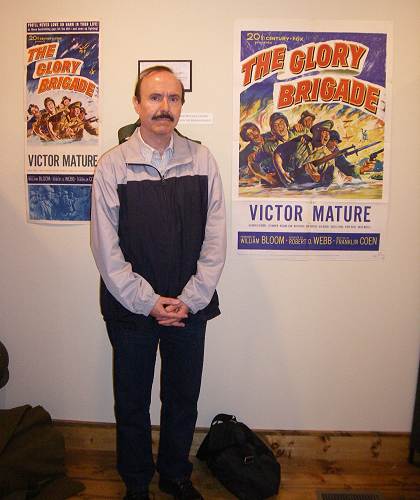
02 Mike Wieneman
Mike’s narrative, which is relatively brief, is oriented toward featuring a number of old photos of Tuscumbia from his huge Miller County collection and it is for that reason I wanted to place it on our website.
I asked Mike how he had learned so much about Tuscumbia history, especially since he was raised in Eldon. First of all, his mother, Irene Elizabeth Clark Wieneman, was born and raised in Tuscumbia. Her Clark ancestors had lived in the Tuscumbia area for a couple of generations having arrived there from around Eldon. His grandfather, George Clark, had married Lena Alice Scott, a descendent of Thomas Scott, who was a resident of Tuscumbia and a former state senator. You can read more about Mike’s Miller County and Tuscumbia background at this previous Progress Notes where Mike has recorded a very interesting account of the Clark family.
But perhaps most of his learning about Tuscumbia came from a cousin who was raised in Tuscumbia. Here is what Mike wrote me about his resources concerning Tuscumbia history:
Joe,
My 2nd cousin Lura (Clarke) Walton shared a lot of information with me.
She was a daughter of Tuscumbia residents Charles and Mattie (Clark) Clarke. She was also a half sister to Louie (Clarke) Lawson.
I got some photos identified in 1974 when I went to visit Lura in Kansas.
Lura was born and raised in Tuscumbia. She left Tuscumbia with her parents for Kansas City, Missouri about 1910.
I asked a lot of questions about old photos that I had and also showed them to various family members.
I had a great time back then discussing my family history with people that were still living.
Mike
|
So with that introduction here is Mike’s Tuscumbia history as published in the book Fiftieth Anniversary of Bagnell Dam:
Tuscumbia
Mike Weineman
Fiftieth Anniversary of Bagnell Dam
1981
p.248
Tuscumbia is the oldest laid out town in Miller County, and is the county seat. In 1889, The Anchor Roller Mills, owned by P.F. Hauenstein, and the steamboat, “The Frederick,” owned by W.H. Hauenstein and R.M. Marshall, were the heaviest enterprises of Tuscumbia (photos 03 - 07).
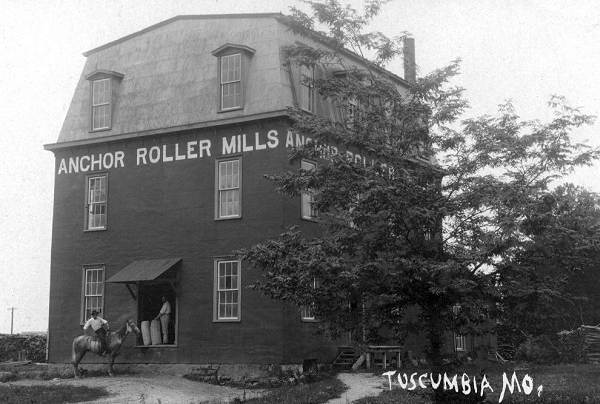
03 Anchor Roller Mills
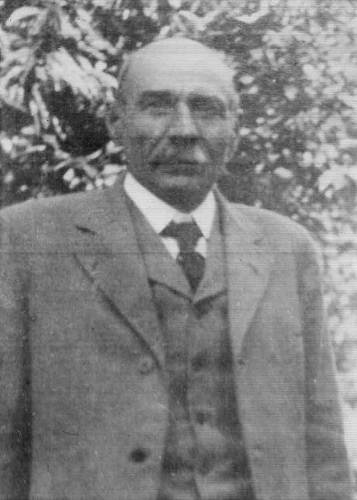
04 Phil Hauenstein
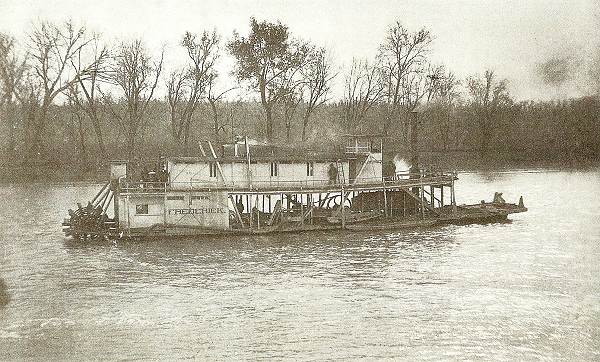
05 Frederick on the Osage
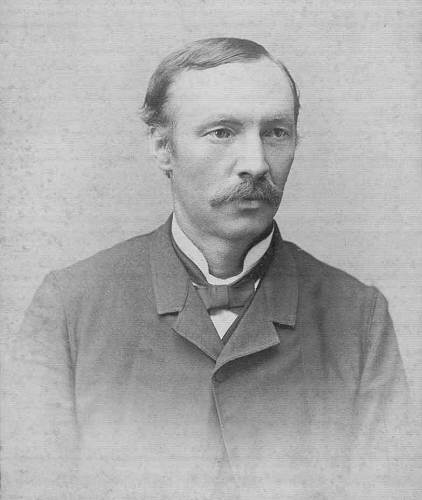
06 William Hauenstein II
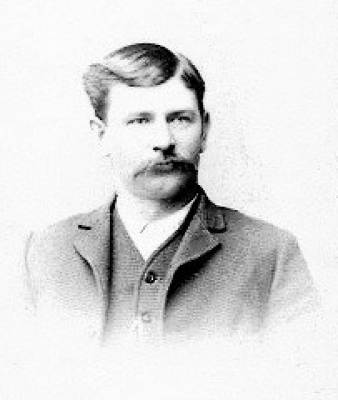
07 Bob Marshall
The general merchants were: Hauenstein & Company, Simpson & Company, and F.W. Fendorf (photos 08a - 10).
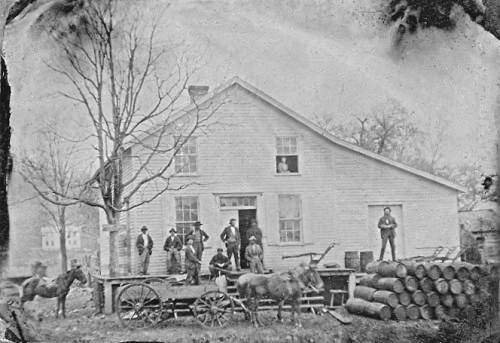
08a Tintype of the First Hauenstein Store in the 1880's
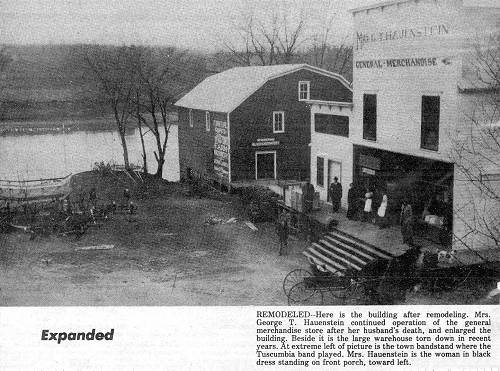
08b Hauenstein Store Remodeled
Click image for larger view

09 Frank Fendorf Family
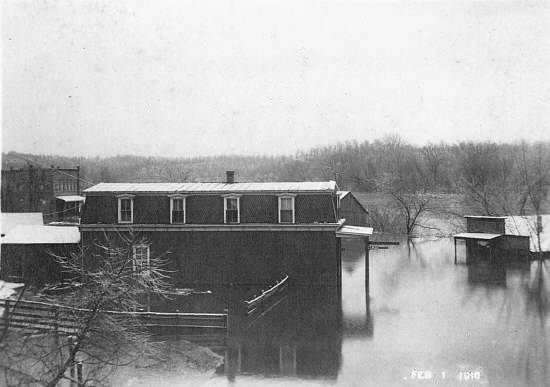
10 Fendorf General Store during Flood
Dr. J.B. McGee and I.T. Johnson dealt in drugs (photo 11).
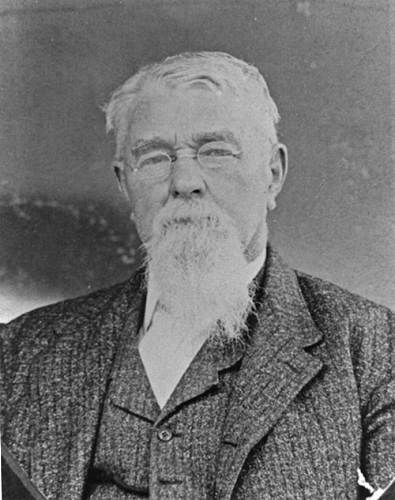
11 Dr. James McGee
B.F. Lawson had a grocery store (photo 12).
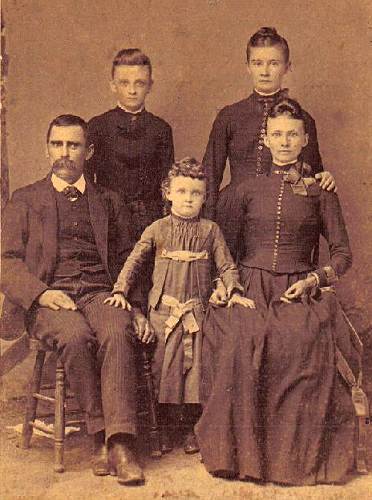
12 Benjamin F. Lawson and Family
The ferry was managed by I.T. Johnson (photo 13).
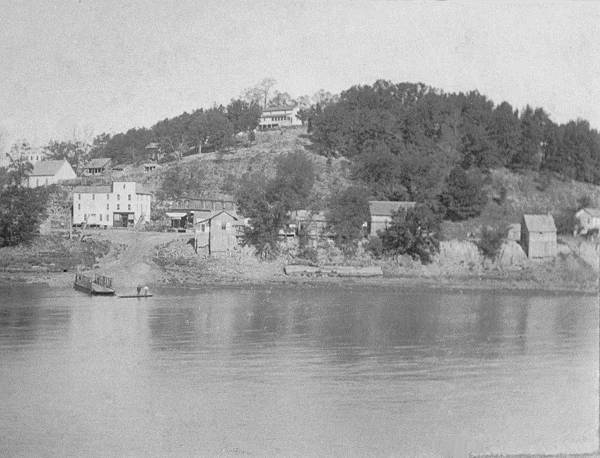
13 Ferry looking North
The hotels were: The Home, by L. Bacon (photo 14); the City Hotel, by Mrs. E.A. Freeman; and the Kentucky House, by Mrs. J. Bell.
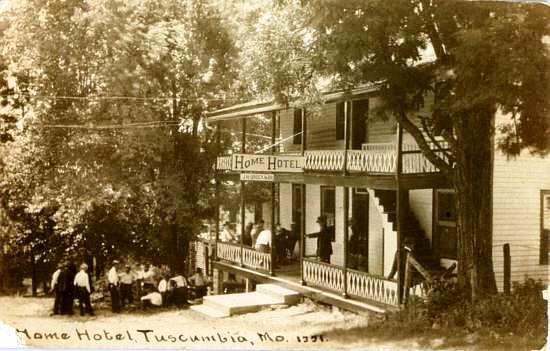
14 Home Hotel
J.W. Fogleman had livery barns (photo 15);
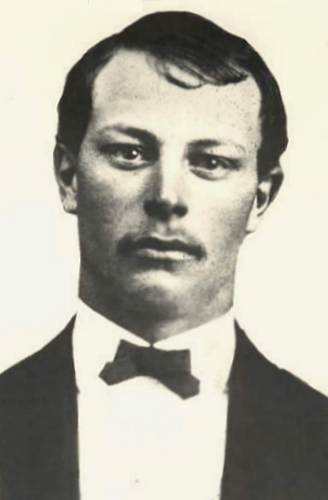
15 John Fogleman
G. W. Bacon ran the Aurora Hack Line and mail.
Page Thompson had a shoe shop and the barber was I.N. Reed.
John Kallenbach and John Weitz had charge of the blacksmith and wagon trade, and the saddler was H.W. Carty (photo 16).
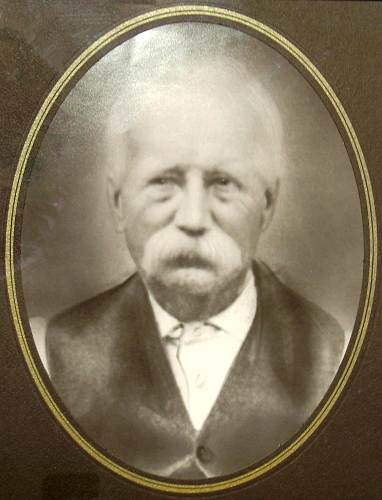
16 John Kallenbach
Mrs. C. Wright and Mrs. E.C. Swalem were milliners.
Hauenstein and Marshall were stock buyers.
The quarries were owned by Dr. J.B. McGee and W.J. Welshon.
The contracting and carpenter work was done by J.H. Willis, and J. Jukes was a mason. P.F. Hauenstein had a lumber yard.
Charles Fulkerson was the photographer.
Simpson & Co. were tie contractors.
The resident bar was composed of T.B. Robinson, E.C. Swalem, L.N. Musser and E.C. McEntire (photo 17).
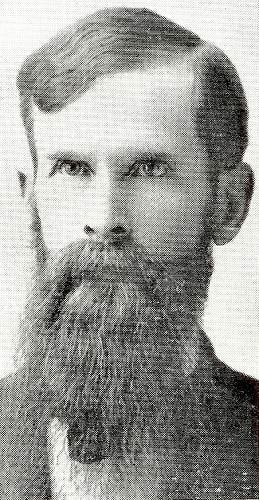
17 T.B. Robinson
Robinson also was an abstractor of title and McEntire was an insurance agent.
The medical fraternity was represented by Dr. J.B. McGee and S.W. Ewell.
There were three churches and a school (photos 18 - 21).
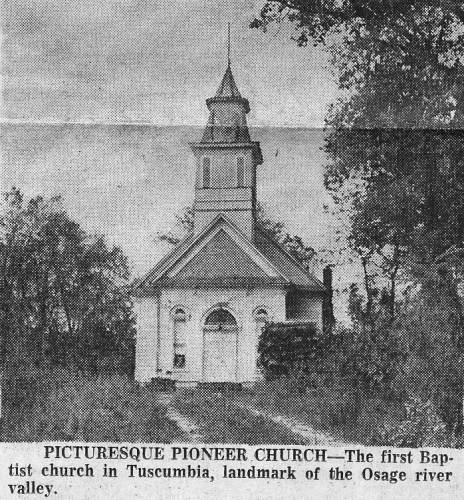
18 Tuscumbia Baptist Church
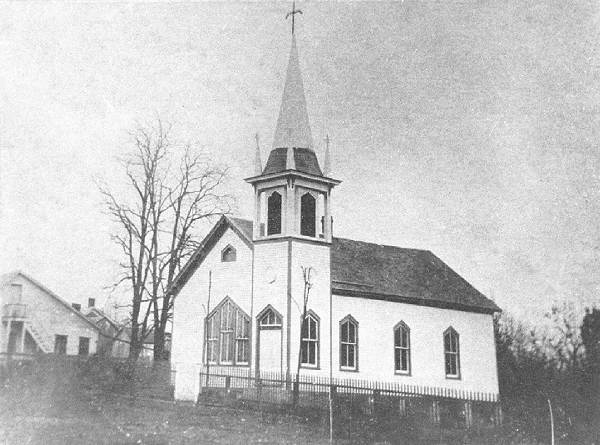
19 Christian Church

20 Presbyterian Church on Left
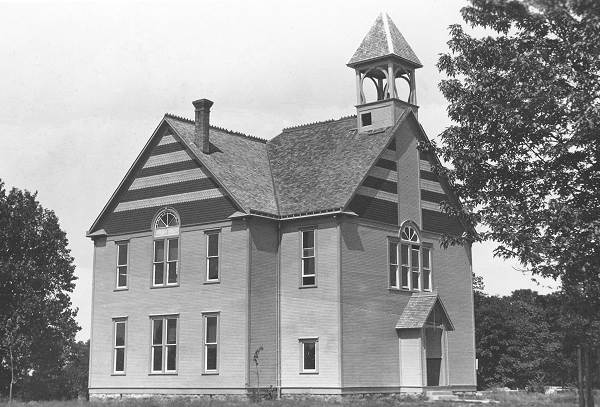
21 Third Tuscumbia School
After presenting the previous general narrative Mike featured some photos for which he had particular information:
Tuscumbia Landing
(photo 22)
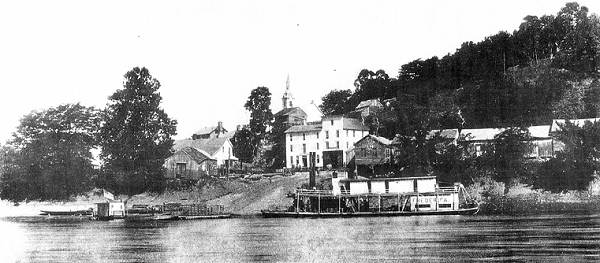
22 Steamer Frederick at Tuscumbia Landing
To the left of the Frederick steamboat is the old ferryboat, which was used to convey traffic of all kinds across the river, and in connection with which many interesting stories could be told. The four story Johnson building, which was destroyed by fire a number of years ago, is one of the conspicuous buildings in this picture. In front of Hauenstein’s store a car load of salt, in barrels, is noted. Back in those days Osage river merchants usually bought salt in car lots. Several buildings are seen in this picture which will appear strange to the present generation. Some have been replaced by other buildings while some have been wrecked or destroyed by fire.
Anchor Roller Mills
The first milling facilities had been located where Riverside Park is now (photo 23).
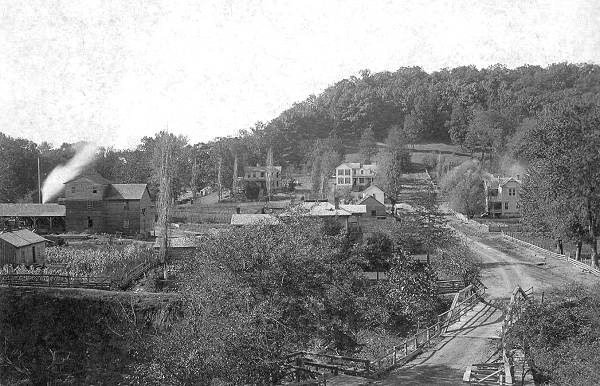
23 Original Mill on left of Road
The second site was selected in 1894 by Phillip Hauenstein for the new roller mills building near the Osage River, higher than Riverside Park, because he thought the Osage would never reach it (photos 24, 25 and 26).
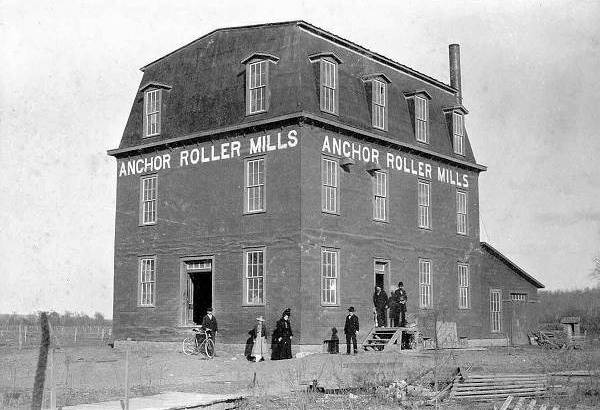
24 Anchor Roller Mills Second Site
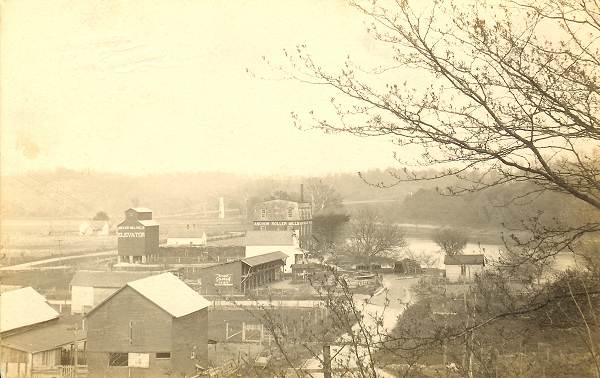
25 Anchor Mill - East End
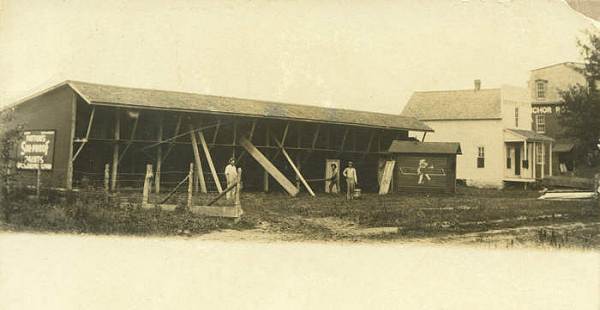
26 Anchor Milling Lumber Shed, Office and Mill - East End
The next year the flood of 1895 came. A timber from this building, showing the depth and date of that flood, was used in the Anchor Milling building in Eldon where the carved records are visible in the basement. Depth was far short, though, of that reached by the flood of 1943. This building was located downstream and across a ravine, crossed by bridge, from the hardware building which still stands on the river bank. After the flood of 1943 the flour business was discontinued and the feed mill was moved atop the hill to a new building on Highway 52 in 1949 near a rock hardware building erected earlier (photos 27, 28 and 29).
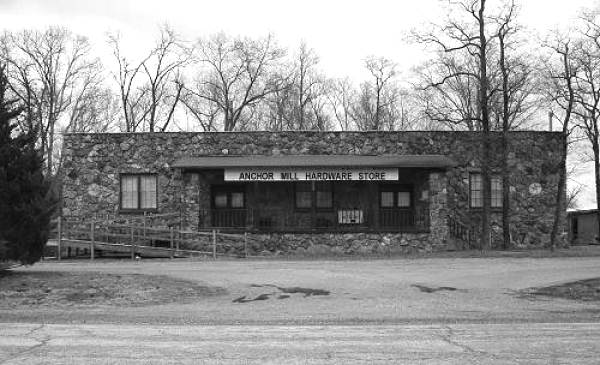
27 Anchor Milling Company Hardware Store moved up to Hilltop
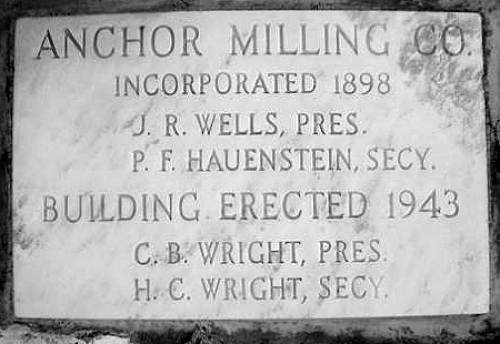
28 Stone Engraving Anchor Milling Company Hardware Store on Hill
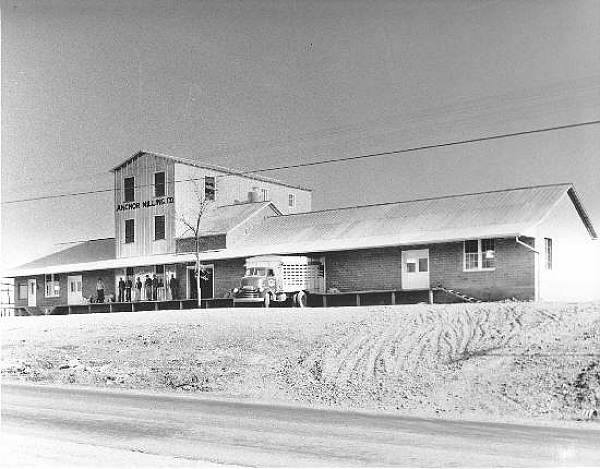
29 New Mill on top of Hill
Historic Buildings Survey
The Wells House
(photo 30)
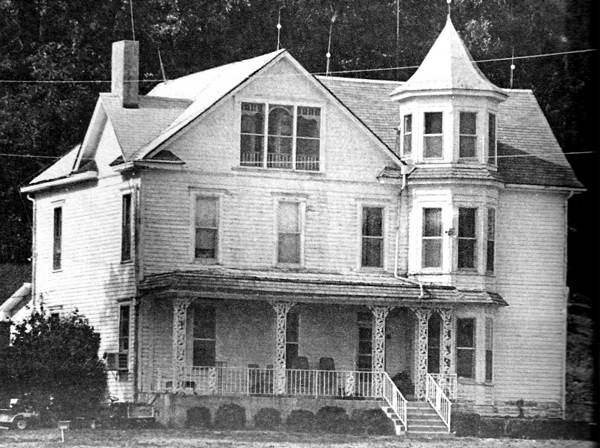
30 Home of J.R. Wells
The “Wells House” near Tuscumbia is one of over 150 historic sites inventoried in northern Miller County in the L.O.C.L.G.’s (Lake of the Ozarks Council of Local Governments) historic preservation survey. Several sites from the survey, including the Wells House were recommended for nomination to the National Register of Historic Places. With most of the survey work completed, the program is now focusing on a summary report and development of a historic management plan, which will include background, methodology, results and recommendations.
The Wells House was built in 1889 by J.R. Wells, whose father, Charles Wells, homesteaded the farm not long after arriving in Missouri from Wheeling, West Virginia. In 1902, J.R. Wells made major renovations and expanded the house to three stories and ten rooms including a bathroom and pantry. History also notes that one of Tuscumbia’s most well known steamboats was named after the same J.R. Wells (photos 31, 32 and 33).
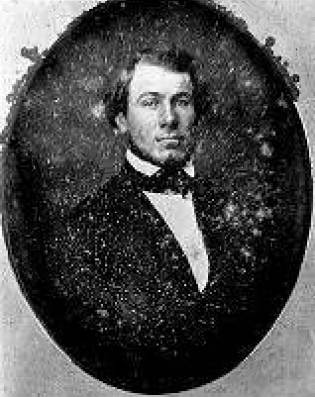
31 Charles Wells
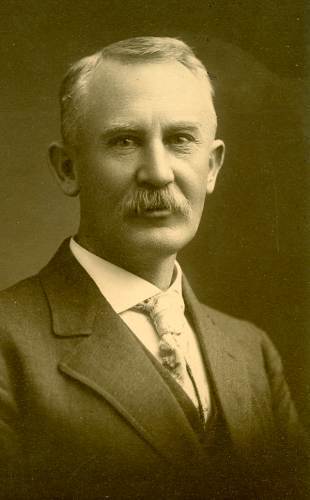
32 J.R. Wells
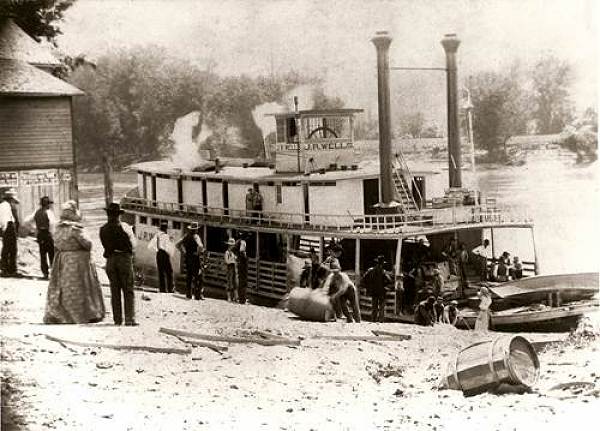
33 J.R. Wells unloading at Tuscumbia Landing
Main Street Tuscumbia (photos 34 and 34a)
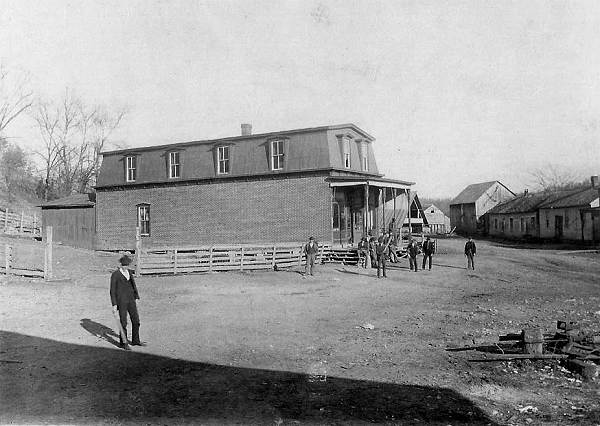
34 Tuscumbia Main Street - Late 1800's - George Swanson in Foreground
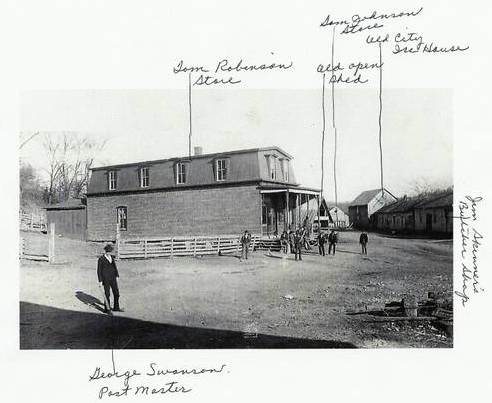
34a Tuscumbia Main Street Diagram
This photo is of a part of Main Street in Tuscumbia. The large building on the left was Tom Robinson’s store later owned by the Haynes Brothers. Frank Fendorf and others owned it also. An old open shed is dimly seen by it. Across the street is Sam Johnson’s Store and Jim Skinner’s butcher shop. The taller building is the old city ice house. All these smaller buildings washed away by flooding of the Osage River about 1900. George Swanson is in the foreground.
Four Old Time River Men 1891 (photo 35)
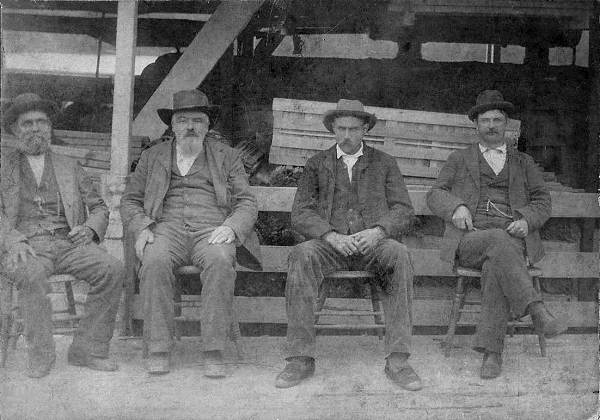
35 Four Old-Time Rivermen
This picture was taken on board the Steamer Hugo in the year 1891 (photo 36).
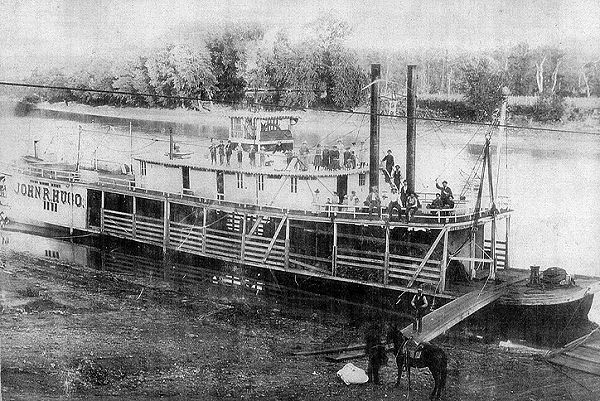
36 John R. Hugo owned by Bob Marshall
Reading from left to right, the men are: M.W. Grant, chief engineer of the Steamer John R. Hugo: F.G. Schoenen, general agent of the Missouri and Osage River Packet Company, Osage City; Henry Castrop, secretary and treasurer of the company and master of the steamer Frederick; R.M. Marshall, president and general manger of the company and master of the Steamer John R. Hugo. The photo was taken by Grant’s brother, who then owned a studio at Lamar, but was then spending a two month’s vacation on the Osage.
Looking North From West Side of Town 1880’s (photos 37 and 38)
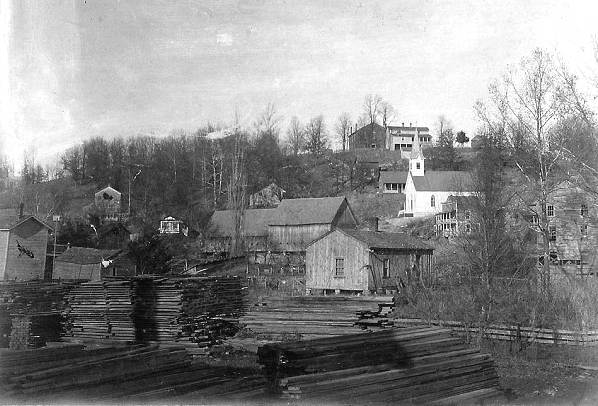
37 Tuscumbia - Late 1800's
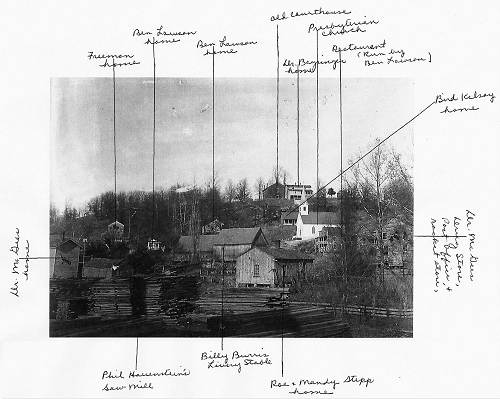
38 Tuscumbia - Late 1800's Diagram
The old Court House (before new one was built in 1910) is on top of the hill. The white house slightly to the right is the Dr. Baysinger home. The house on the hill side partly shown is Bird Kelsay’s home which burned about 1898. The building just below the Presbyterian Church was a restaurant run by Ben Lawson first and then by Burrell Burris later. To the right of it is a large building partly hidden by trees which contained the post office, racket store, DR. McGee’s drug store and some living quarters on the upper floor. Charles Clarke once owned it. It was wrecked about 1915. In the foreground is Phil Hauenstein’s saw mill. The large house with an X on the left was Dr. McGee’s home, the small house with an X on the left was Roe and Mandy Stepp’s home. Later, Mose Broom (river ferry man) and his wife lived there. The large building with an X was Billie Burris’s livery stable. The White house above that with an X was owned by Ben Lawson and also the white one back of the livery barn. The large house with a red dot, was the old Freeman home, which once was a hotel.
Village Photographer (photo 39)
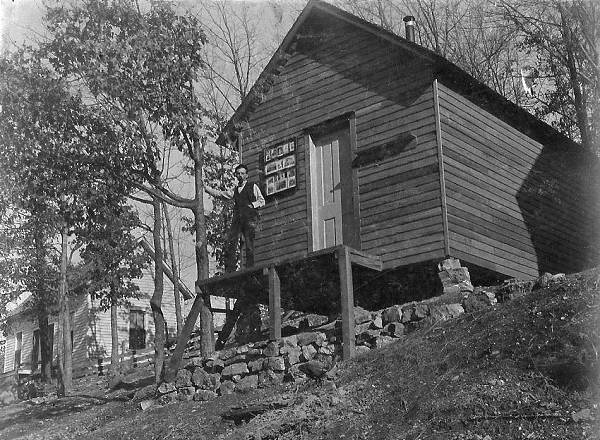
39 Walter Scott, Photograher
Walter Scott on the porch of his photograph gallery in Tuscumbia. His residence is on the left.
Charles H. Clarke (photo 40)
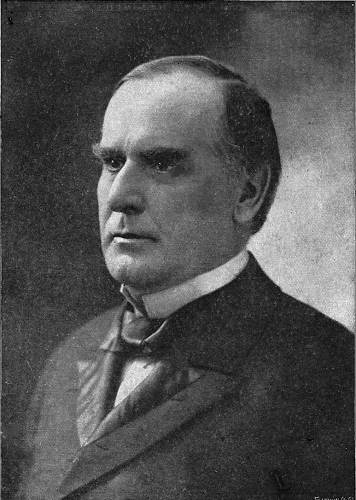
40 Charles H. Clarke
Charles Clarke was an Englishman for whom the Clarke development was named located on the west side of Tuscumbia along the Tuscumbia Versailles Road. It is the area colored pink on the left side of this old map of Tuscumbia (photo 41).
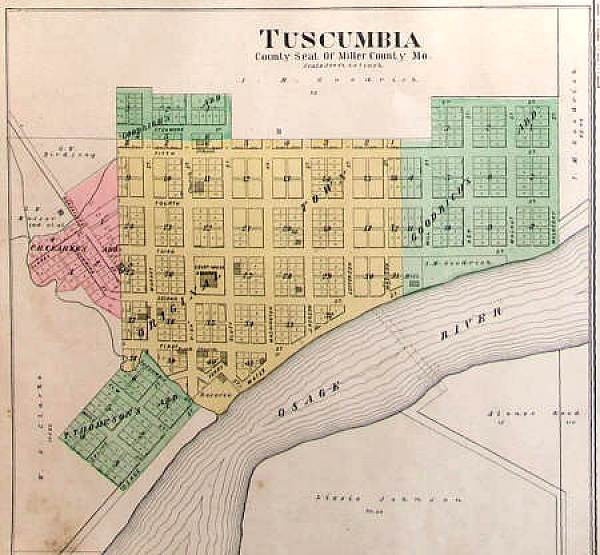
41 Old Map of Tuscumbia
Part of Tuscumbia Main Street late 1800’s (photos 42 and 42a)
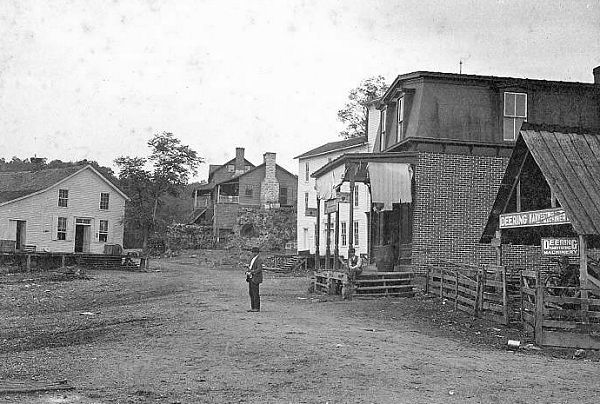
42 Hauenstein's Store on Left - Tom Robinson's Store on Right
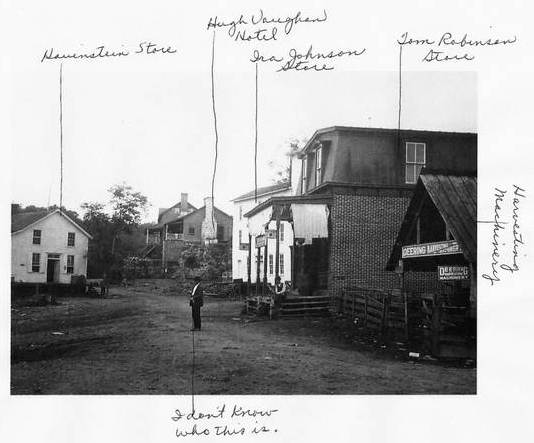
42a Hauenstein's Store on Left Diagram
Old open shed to far right is used for storing harvesting machinery, the large building next to it is Tom Robinson’s store, the large white building slightly to the left is owned by Ira Johnson containing general store and saloon. The white building on the left across the street is William Hauenstein’s store. The large building at the far end on the hill is Hugh Vaughan’s hotel.
Ginger Ridge School
(photo 43)
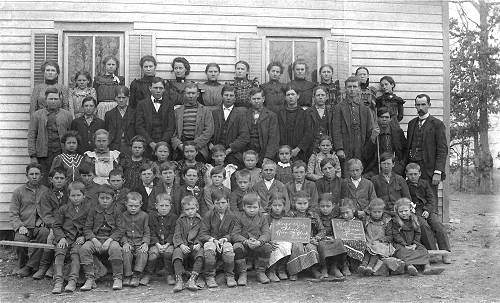
43 Ginger Ridge School - 1900
Click image for larger view
Ginger Ridge School of 1900 was located five miles northwest of Tuscumbia on a country road. About 1907 the frame building burned down and a concrete structure was erected which still stands. The last school taught here was in 1950-51. Leola Slote was the teacher that year. The district then united with the Tuscumbia RIII school district. The pupils that attended school are named as they were in 1900. Married names and those who are deceased were not known.
Front row, from left: Lester Bowden, John Tracy, Elza Sibert, Willard Bowden, Earl Thompson, Manuel Cotton, Billie Odom, Effie Harris, Rosa Gilmore, Rissie Cotten, Magie Meyer, Mattie Harris and Anna Carrender.
Second row, from left: Willard Carrender, Elmer Gilmore, Jim Tracy, Charles Gilmore, Lee Kallenbach, Ira Bowden, Ira Clark, Clarence Harbison, Ira Thompson, John Darity, Warren Meyer, John Harbison, Charles Darity, Roy Smith and Jim Allison.
Third row, from left; Olie Welhouns, Maud Smith, Sarah Meyer, Ethyl Odom, Mary Meyer, Mary Stepp, May Carrender, Jennie Darity, and Vertie Sibert.
Fourth row: Charley Carrender, Ed Harbison, Clyde Bowden, Byron Clark, Herb Carrender, Jim Kallenbach, Oscar Carrender, Walter Wright, Lawrence Meyer, Dan Thompson, Orville Shackleford, and Dion Clark, teacher.
Note: be sure and read to the end of this narrative to learn more about Dion Clark.
Back row: Sarah Cotton, Ema Sibert, Rena Hicks, Lizzie Bowden, Chloe Roark, Lucy Stepp, Stella Harbison, Opal Roark, Stella Cotton, Cora Allison, Rainy Shackelford and Grace Roark.
This was the first school Earl Thompson, owner of the picture attended (photo 43a)
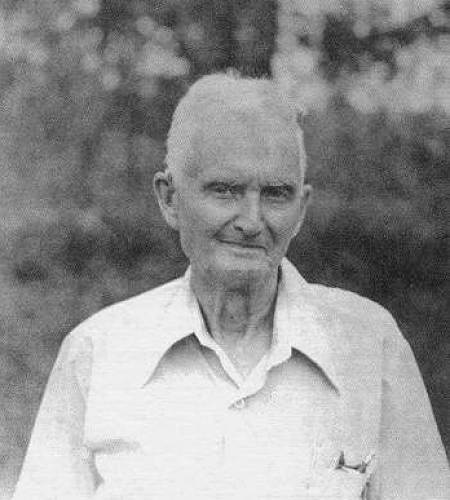
43a James Earl Thompson
Kelsay’s Orchard
(photo 44)
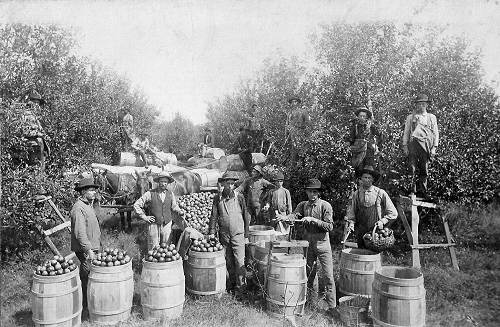
44 Kelsay Orchard
Click image for larger view
Harmon Kelsay was the owner of this orchard located near Tuscumbia. Harmon was the son of James Johnson Kelsay who was a brother of Margaret Kelsay Clark.
3rd Tuscumbia School (photo 45)
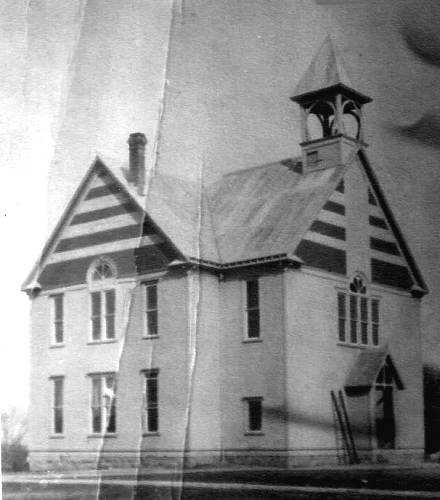
45 3rd Tuscumbia School
Note: The story of this school was discussed in a previous Progress Notes.
Old Brick Courthouse in 1901 (photo 46)
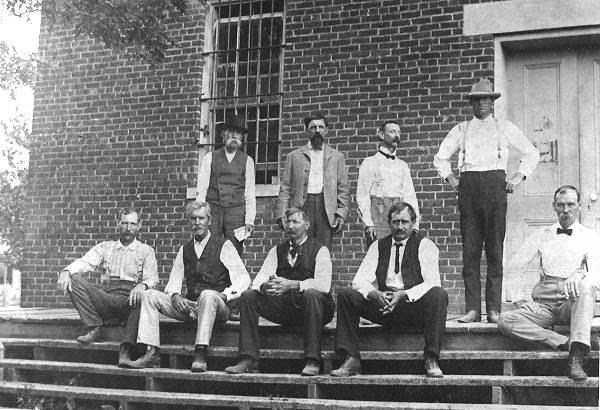
46 Old Brick Courthouse - 1901
This courthouse was rebuilt in 1910 at which time limestones were cut and placed around the brick structure which in some areas made walls that were four feet thick. The men posing for the photo all were officers of the county:
Sitting from left to right: John E. Kallenbach, treasurer; John Bear, probate judge; Joseph E. Lurton, presiding judge of the county court; James Weaver, judge of the 1st district; William M. Harrison, circuit clerk and recorder of deeds. Standing: Billy Clark, deputy county clerk; George W. Payne, judge of the 2nd district; Charles H Clarke, county clerk; Anton Paul Nixdorf Jr., sheriff.
Old Wright Carding Mill (photo 47)

47 Wright's Carding Mill
This old water mill used for carding and grist milling was located three miles north of Tuscumbia on the Little Saline Creek and was owned and operated by Green Lee Wright. The visitors are Billy Harrison and his Sunday School class from the Christian Church at Tuscumbia. Seated from left are (maiden names) Gardie Swanson, Gretchen Bacon, Anna McBride, Anna Clark, Hortense Swanson, Lura Clarke and Majd Clark. Standing behind: Ethyl Moles and Billy Harrison. Over on the right: Green Lee Wright and his son, Charley. The photo was taken in 1903.
Steamboat Ruth (photo 48)
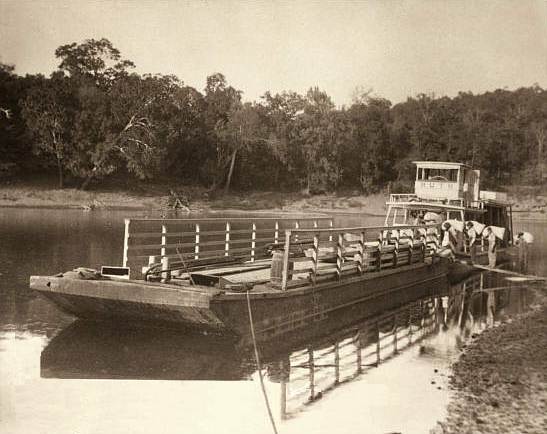
48 The Ruth with Barge
From 1909 to 1920 the gas vessel “Ruth” was operated. It was named for Ruth Wells, daughter of Joshua R. Wells. The photo was copied from one possessed by Ed Wright, who worked on the boat (photo 49).
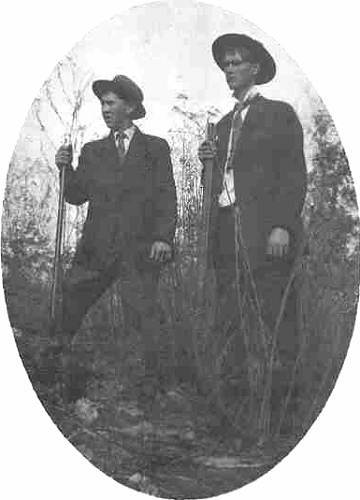
49 Cousins Pittman and Ed Wright
J.R. Wells Steamboat (photo 50)
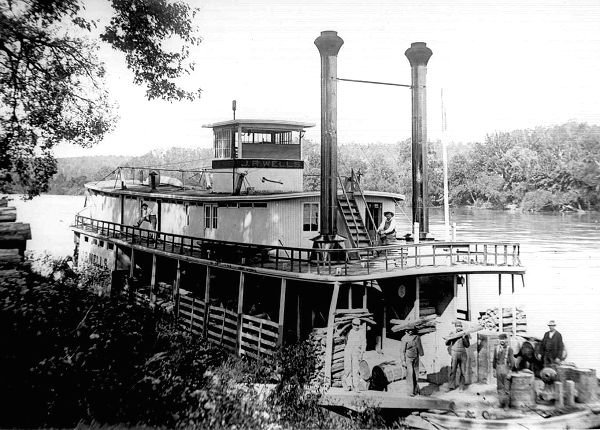
50 J.R. Wells with Men in Front
The J.R. Wells steamboat at Wide Ford, Camden County as photographed in 1905. The crew members pictured are Ben and William Bear, Charley Greenup, Will Nichols, Aaron Wright, and C.B. Wright.
Clarke Mansion (photo 51)

51 Ed and Lela Clark's Last Home
This home was built originally by Charles H. Clarke, originally from England. Charles’ second wife, Mattie Clark, was a sister to Ed Clark (no relation to Charles). Ed Clark and his wife, Lela Hauenstein Clark, purchased the home from Charles and Mattie. It was their last home.
Ed Clark served as County Clerk in 1913 (photo 52).
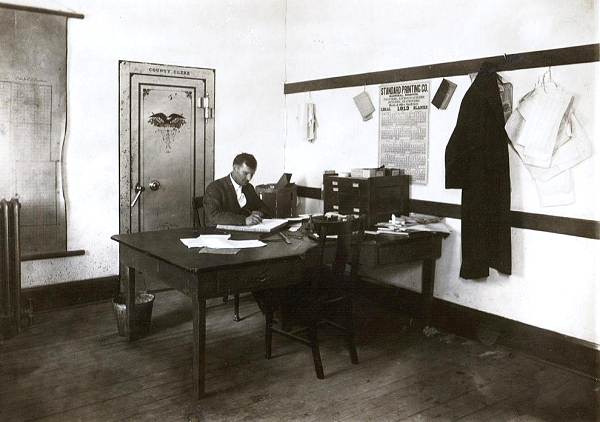
52 Edward P. Clark, County Clerk - 1913
View of Tuscumbia 1923 (photo 53)
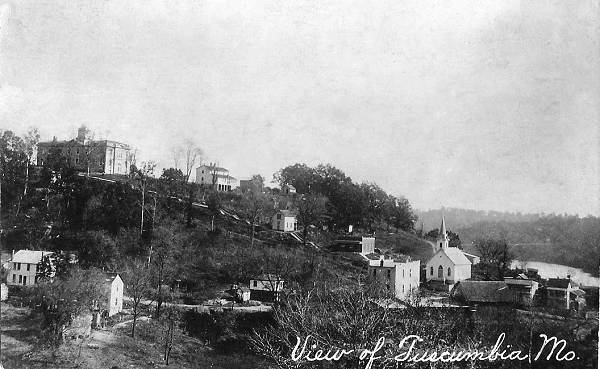
53 View of Tuscumbia from West Side - 1923
In this view of Tuscumbia, the rebuilt courthouse of 1910 is observed at the top of the hill. To the right is a building originally built by I.M. Goodrich in the mid to late1800’s, later owned by Dr. Baysinger and later operated by Belle Fancher as a hotel.
Note: You can read about the structure at this previous Progress Notes.
Going down the hill is a white home owned by various individuals over the years. Below it is a brick office building owned by attorney Walter Stillwell. Further down the hill is the Presbyterian church and in front of it the Bank of Tuscumbia. Other buildings below the church and bank were identified in some of the photos above.
Ernest Fendorf and his New Motor Boat (photo 54)
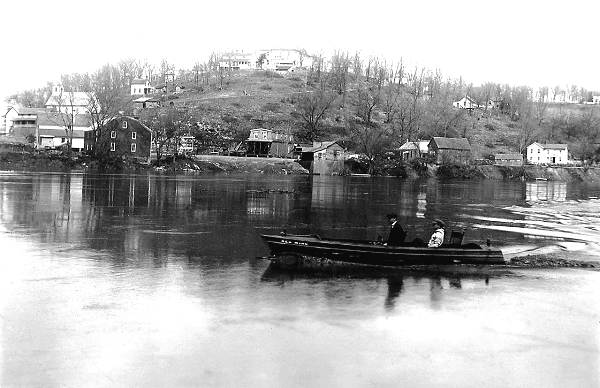
54 Earnest Fendorf in one of Tuscumbia's first Motor Boats
Not much is known about the gas powered boat except that it most likely was purchased before the mid 1920’s since within that time frame the Fendorf/Swalem building in the background center of the photo had burned in the mid to late 1920’s.
Note: You can read more about the Fendorf family at this previous Progress Notes.
In the narrative above I should point out that Edward P. Clark, who was the county clerk pictured in photo 52, was a brother to Mike’s grandfather, George Clark.
Another Clark relative of Mike’s, named Edward L. Clark, was a brother to Mike’s great-grandfather William G. Clark (photo 55).
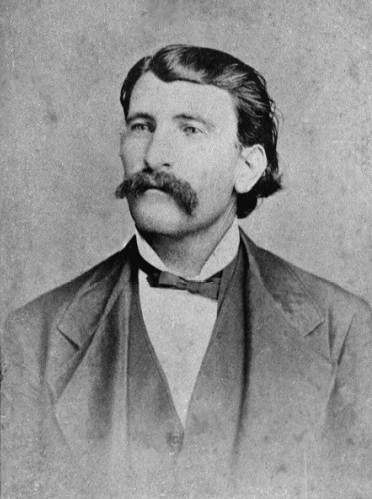
55 Edward L. Clark
He was also an uncle of Edward P. Clark. This later Edward was named for him.
Edward L. Clark had a very interesting history and his story can be found at several sites on the internet. The following is Edward L. Clark’s story as told by Mike:
Edward L. Clark was born September 20, 1845 in Sullivan County, Tennessee. He later lived in Miller County, Missouri around Mt. Pleasant when the town was called "Pleasant Mount having moved there with his parents. This was at the time of the Civil War. But later after the Civil War he went to Oklahoma to the Indian Territory where he became an interpreter, a Sub-Agent, and a dispenser of medicine at the Indian Reservation near Fort Sill, Indian Territory, Oklahoma. Sometimes he was directed to travel to Washington D.C. regarding tribal negotiations (photo 56).
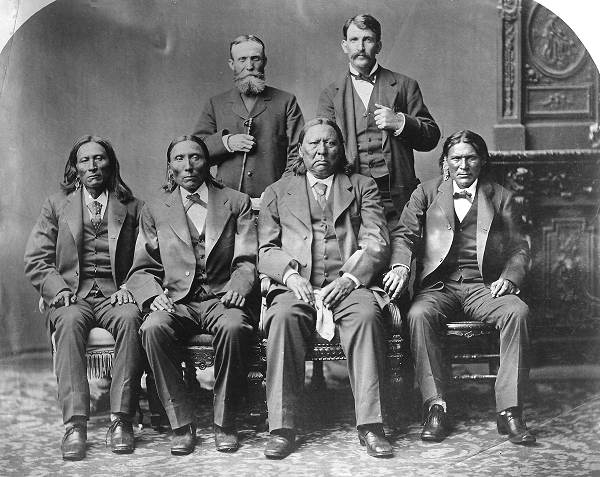
56 Edward L. Clark in Washington D.C. Indian Affairs Meeting
Caption for Photo 56: 1880, seated left to right: Tsodiako (Wichita), Tak-a-i-tai-di (Kiowa Apache), Set-imkia or Stumbling Bear (Pushing Bear)(Kiowa), and Kobi (Commanche) in Washington, D.C. meeting. Edward L. Clark, top right
Note: This photo was included in the 50th Anniversary Bagnell Dam article Mike wrote about Tuscumbia.
Edward was married April 7, 1883 in Indian Territory, Oklahoma to Wau-ma-co-nie (or Woomaconie) (photo 57).

57 Waumaconie (or Woomaconie)
She was a Comanche Indian girl born November 1868 in the Antelope Hills, Rogers Mills County, Oklahoma and died November 15, 1946 in Deyo Mission, Comanche County, Oklahoma. Edward L. Clark died February 2, 1914 in Deyo Mission, Comanche County, Oklahoma. Both are buried in Lawton, Comanche County, Oklahoma in the Deyo Mission Cemetery (photo 58).
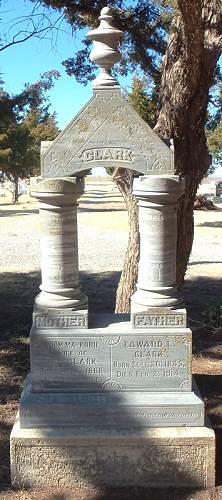
58 Deyo Mission Cemetery
Edward and Wau-ma-co-nie Clark were the parents of 11 children:
1. Elsie (Clark) Southard, born 1884, died 1944.
2. Parker Clark, died 1898.
3. Benjamin H. Clark, born 1888, died 1907.
4. Edward H. Clark, born 1890, died 1959.
5. Lewis Clark, born 1894, died 1940.
6. George L. Clark, born 1896, died 1944.
7. William McKinley Clark, born 1898, died 1942.
8. Mary Clark, born 1902, died 1902. (twin)
9. Theodore Clark, born 1902, died 1902. (twin)
10. Joel Barker Clark, born 1903, died 1990.
11. Albert Clark, born 1906, died 1997.
A photo of Woomaconie was featured in the Tuscumbia article written by Mike in which she is accompanied by Eldon resident, Harry Vernon (photo 59).
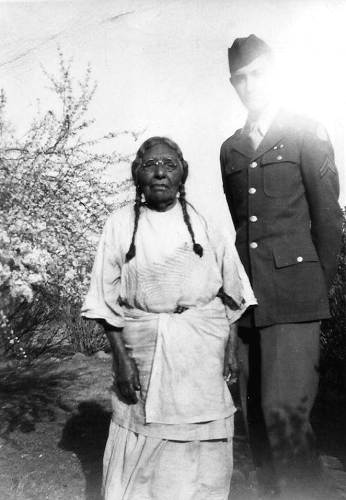
59 Aunt Woomaconie, Wife of Edward L. Clark- with Harry Vernon
I didn’t understand the connection between Woomaconie and Harry. Here is Mike’s explanation:
The soldier is Harry Vernon from Eldon. You probably knew him. Harry Vernon's mother was Grace (Clark) Vernon. It was the same Clark family as mine. Aunt Woomakonie was a great-aunt to Grace the same as was to my mother.
That older Edward L. Clark was a brother to Joel B. Clark that worked in the courthouse and also to my great-grandfather William G. Clark who also worked in the courthouse.
Harry Vernon had the music store in Eldon. While he was in WWII he went to Oklahoma to visit the Clark family. Some of the brothers and sisters to his grandfather Jim Clark were living there. They all went out there to live in Lawton and Faxon Oklahoma to live near this older Uncle Ed Clark.
Harry's family of Clark's were, Mae, Grant, Dion, Joel Jr., and their mother Eliza. After the death of Joel B. Clark, Sr. in 1900, some of his children moved out there, the ones that I have just named. The Clark brothers opened a general merchandise store during the early 1900's in Faxon, Oklahoma.
I'm sending a photo of this family that lived in Oklahoma, Harry's great-grandmother and some of her children. Jim Clark is not on here since he stayed in Tuscumbia.
In the photo the mother is Eliza with her children.
This is the same Dion Clark that was a school teacher at the Ginger Ridge School in 1900 (photo 60).

60 Joel B. Clark Jr., Eliza, Grant, Mae and Dion Clark
I must say that I knew Harry Vernon all my life growing up since I frequented his music store in Eldon often. I certainly didn’t know about his relatives who had moved to Oklahoma.
For our readers I know that putting together all the connections of Mike’s Clark family may be confusing. However, if you take the time to read the Progress Notes of March 22, 2010 you will find that Mike very carefully presents the descendency of his Clark family including many photos.
If you would want to learn more about Edward L. Clark’s experiences in the Indian Territory of Oklahoma I refer you to these two websites:
http://www.ftsillindianagencycemetery.com/people-indexes/clark-twins/
http://www.ftsillindianagencycemetery.com/people-indexes/moxie/
This completes the photo/narrative of Tuscumbia by Mike Wieneman. I am certainly grateful to Mike for supplying us originals of the photos used for the article in the book, Bagnell Dam Fiftieth Anniversary as well as taking the time to review details, make the diagrams and offer additional interesting information.
Peggy Hake also wrote a short narrative for the 50th Anniversary Bagnell Dam book detailing the history of the very beginning of Tuscumbia. Her narrative followed immediately that of Mike Wieneman’s article above:
Tuscumbia
50th Anniversary Bagnell Dam
1981
Peggy Hake (photo 61)
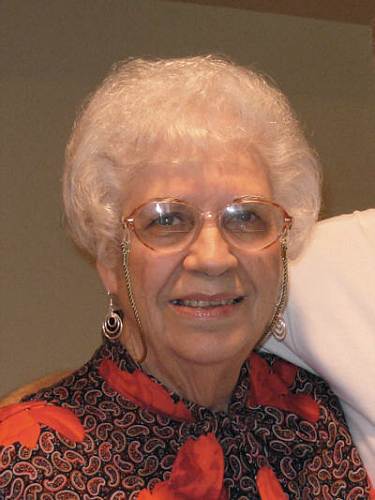
61 Peggy Hake
Tuscumbia was an Indian trading post in the early 1800’s with trappers, explorers and adventurers floating up river in canoes and flat boats trading with Indians. John and James Proctor Harrison, brothers, built a log trading post on the slough of “Shut In” Branch and called it “Harrison’s Plantation.” Later, Daniel Cummings built merchandising business in the area and Jesse Kendrick opened a saloon. Later Daniel Cummings built the first hotel in the town.
In 1837, Miller County became a separate county breaking away from Cole County to the north and Tuscumbia was selected as the seat of justice. J.P. Harrison donated fifty acres of land to the area for the town site and the first terms of court were held in the home of William Miller who lived on a hill at the mouth of Saline Creek.
The post office at Tuscumbia was established on December 21, 1837 with James P. Harrison as the first Postmaster.
Tuscumbia remains the county seat of Miller County and has had that distinction for 143 years. Her present courthouse was built on the hill overlooking the beautiful Osage River in the early portion of the 20th century.
Note: This narrative was written more than 30 years ago. Since then the present courthouse, the county’s fourth one, now is located on Highway 52 about a half mile north of the previous one which is still standing, overlooking the Osage River.
Helen Wall, past president of the Miller County Historical Society, passed away last January 26. She and her husband, Lewis Wall, were very active early on in the history of our society and continued to be involved until just a few years ago when her health began to deteriorate. She and Lewis donated many historical items to our museum through the years including this portrait of Lillian Wright, painted by Francesca Wright, Helen’s aunt (photo 62).
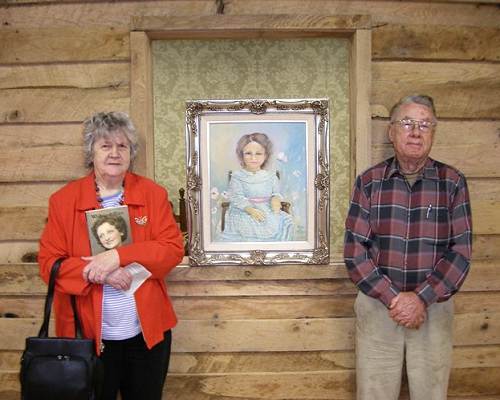
62 Helen and Lewis Wall
You can read more about this gift on our website at this previous Progress Notes.
Copied here is Helen’s obituary:
Helen M. Wall
(February 23, 1931 - January 26, 2012)
Helen M. Wall, age 80, of Iberia, passed away Thursday, January 26, 2012, at Lake Regional Health System in Osage Beach. She was born in Allenton, Missouri on February 23, 1931, daughter of the late Arley and Nellie (Wright) Pemberton. In 1952 in Harrison, Arkansas, Helen married James Lewis Wall, who survives at the home.
Helen served as past President of the Miller County Historical Society and was a past member of the Daughters of the American Revolution. She was a member of the Iberia United Methodist Church.
She is also survived by five children, Donna Sue Wall of Kaiser, James Lewis Wall Jr. and wife Lynn of Eureka, Terry Gale Dotson of St. Charles, John Thomas Wall of Iberia, and Carol Jean Wall of Valley Park; nine grandchildren; six great-grandchildren; one sister; and five brothers.
She was preceded in death by one brother, Gail Pemberton.
A graveside service will be held at 1 p.m. on Saturday, January 28, 2012, in Mt. Union Cemetery near Brumley. Rev. Ron Orr will officiate.
Memorial contributions are suggested to the Miller County Historical Society.
That’s all for this week.
 Joe Pryor
Previous article links are in a dropdown menu at the top of all of the pages.
|

